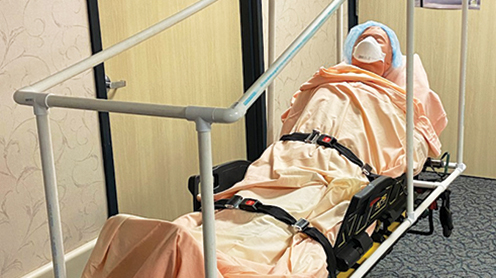Portable patient pod protects EMS crews
Posted on April 1, 2020

By CAITLYN BURCHETT / Staff Writer
In an effort to protect emergency medical responders from the coronavirus (COVID-19), Doctors’ Memorial Hospital (DMH) emergency medical technician (EMT) Steve Wentz has created a “portable patient pod” to help reduce the risk of spreading the virus during transport.
While there are currently no positive COVID-19 cases in Taylor County, the portable patient pod will function as a mobile airborne isolation chamber, being deployed when local emergency medical responders are transporting patients suffering from respiratory illnesses.
The device was designed to be affixed on top of a stretcher over a patient, trapping airborne droplets, and reducing healthcare workers’ exposure to the coronavirus during transport.
Constructed only of PVC pipe, a little glue, a clear 9×12 plastic cover and tape, the idea of the portable patient pod stemmed from a similar invention posted on Facebook by an out-of-state fire department.
Wentz’s version of the device quickly grew from a simple 2-D sketch to a fully-functioning pod that fits into an ambulance and does not hinder access to the patient.
“I am not a carpenter, a plumber, or anything like that, but it only took me two hours to get from a sketch on a piece of paper to this,” Wentz said, motioning to the fully-constructed prototype.
The final product is lightweight and stable and simply slides right over the stretcher. The plastic cover is draped over the PVC frame and the edges are taped down in an effort to seal in the patient’s breathing, coughing and sneezing into the pod.
“When babies are born with respiratory issues, they put them in an incubator. I thought, why not do that for adults with respiratory issues that may be linked to the coronavirus? We do not have anything like that available here for when patients are being transported,” Wentz said.
“People wondered how patients are able to breathe in there. I have outfitted it with an oxygen tank, and the patient inside will be wearing a nasal cannula – a lightweight tube placed in the nostrils to supply oxygen – under their medical mask,” Wentz explained.
The goal behind the idea is to keep a patient’s respiratory droplets, which can be expelled through coughing and sneezing, contained inside the portable pod.
“Unfortunately, if we have a suspected patient, we do not get the results back immediately. We can put them in a negative pressure isolated room, which is what the portable isolation chamber is good for – safely transporting a patient through the halls, reducing the risk of exposure to others.”
“When we pull a patient out of the isolation chamber, we can put them on a stretcher outfitted with this device, and from the time they go from our isolation room to the isolation chamber they are going to, maybe at another hospital, they are completely covered, and our people have an additional method of personal protection,” Wentz said. “The plastic is not to protect them. It is to protect the paramedic in the ambulance, the healthcare workers and the general public — anyone the patient on the stretcher may be in close proximity to as they are transported from hospital to hospital or ambulance to isolation room.”
Wentz built the portable patient pod for about $50, with the main expense being from the initial cost of the PVC pipes and angles, which can be sanitized with disinfectant wipes and reused time and time again.
The 9×12 plastic cover is disposable and is designed to be thrown away after each patient, at a cost of about $3 per cover. Placing the frame over the patient and taping the new plastic cover over a patient only requires “an extra moment – a handful of seconds” to do so, ensuring that lifesaving medical care is not hindered by the portable pod application process.
“Trying to get the medical field to manufacture and put one of these out could have cost thousands of dollars. Here at DMH we have limited resources. We have limited personal protection supplies,” Wentz said. “Until we can get this under control, we need a way to protect our people. I am worried about our paramedics, our emergency medical technicians (EMTs), our nurses and doctors in the emergency room.”
Wentz intends to measure and label each PVC piece, make a diagram and send the information to emergency medical service (EMS) departments across the Big Bend Region.
“Maybe Mayo, Madison, Wakulla will make them, too. You really only need one per department in these rural counties. Places like Leon County would probably need more because they have a higher call volume,” Wentz explained.
“People have asked ‘Why don’t you patent it and sell?’ But, it’s not about that. It is about protecting others. I want to make sure everyone is safe,” Wentz said.
“The confirmed cases of the virus are getting closer and closer to us, so we have to start thinking outside of the box about how to protect ourselves. We have our masks, but this is just an extra layer of protection between us and patients. We don’t want to get it and take it home to our families,” Wentz said.
Subscribe to our e-Edition and read the rest of the story. Already a subscriber? Click here to sign in.
Recent Comments